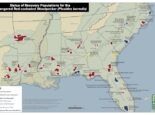The red-cockaded woodpecker is an endangered Southern icon
Why is the red-cockaded woodpecker at risk?
Once common in the South, red-cockaded woodpeckers now number as few as 7,800 active clusters of birds. Logging and fire suppression destroyed much of the longleaf pine habitat where the woodpecker makes its home. As the number of older pines and the size of forests decreased, so did the red-cockaded woodpecker population. The bird has rebounded slightly under decades of intensive management and the protections of the Endangered Species Act, but it’s still found only in isolated pockets of the South. Now climate change is increasing the intensity and frequency of severe storms and rising temperatures that can destroy what habitat the red-cockaded woodpecker has left.
Federal protections are critical to the red-cockaded woodpecker’s survival
In the face of these threats, the federal agency charged with protecting the red-cockaded woodpecker isn’t proposing to maintain or enhance protections for the bird — it’s proposing to remove them. The U.S. Fish and Wildlife Service (USFWS) has proposed to reclassify the red-cockaded woodpecker as a “threatened” species instead of an “endangered” one, even though it hasn’t met the agency’s own criteria for such a downlisting. Instead, USFWS’s own assessment shows that the majority of the woodpecker’s isolated populations are small, with “inherently very low or low resiliency” to withstand environmental threats.
Yet USFWS is considering removing protections for this rare bird, anyway. The move to reclassify it isn’t supported by science and would have serious implications for the red-cockaded woodpecker’s survival — as well as the pine forest habitat the species inhabits. FWS’s latest reclassification proposal is an improvement over what was proposed during the Trump administration but still does not consider the accelerating threats to the species from climate change and habitat loss.
The Fish & Wildlife Service appears to want to claim another ‘recovered’ species, but claiming recovery and achieving it are two very different things.
Ramona McGee, SELC Wildlife Program Leader
SELC is working to save the red-cockaded woodpecker
Alongside our partners, SELC continues to advocate for science-based and climate-conscious decision making for RCWs and all Southern species. Federal agencies like the U.S. Fish and Wildlife Service abandoned science-based decision making in the past, but SELC has been fighting to keep agencies focused on the facts every step of the way. In Charleston, South Carolina, we’re challenging the proposed Cainhoy development for its ill-conceived plans, including failure to consider impacts to red-cockaded woodpeckers on the adjacent Francis Marion National Forest. In 2023, thankfully, the USFWS halted construction on most of the site while the threats to all endangered species in the project area are fully considered. Still, SELC continues to work to restore science to agency decisions, including by advocating for stronger implementing regulations under laws like the Endangered Species Act and Migratory Bird Treaty Act. The law doesn’t allow federal agencies to walk away from species conservation, and SELC is committed to defending the South’s wildlife.

